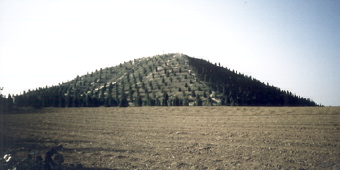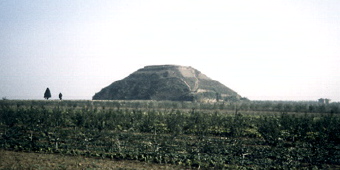..traces man's unending search for immortality to a spaceport in the Sinai Peninsula and to
the Giza pyramids, which had served as landing beacons for it--refuting the notion that these pyramids were built by human pharaohs. Recently, records by an eye-witness to a forgery of an inscription by the pharaoh Khufu inside the Great Pyramid corroborated the book's conclusions.
Mummies? We don't got to show no stinking mummies!, June 30, 1998
[from the
]:
Sitchin brings myth and reality into synchrony in this exciting and credible history of Old Testament times.
You'll never again accept the hogwash that the Giza pyramids were the burial places of (or even built by!) Egyptian pharoahs...
Zecharia Sitchin, ..offers this new perspective on the role the pyramids filled back in ancient history.
"The Sumerians called the Giza Pyramids E.KUR, meaning 'House which is like a Mountain'. They depicted the Ekur on clay tablets by a square-based pyramid with wings, sometimes with a spherical glowing apex, sometimes even accompanied by a lion-shaped statue - clay tablets that go back to approximately 3500BC (proving that the pyramids date to pre-historical times).
"Sumerian and Egyptian mythology both feature wars between the gods in what seems to be a kind of battle between two families of gods for supremacy and control over the ancient lands. Egyptian myth speak of how Seth defeated Osiris and dismembered his body, spreading the body parts throughout the world - only to be beaten by Horus, the son of Osiris. Sumerian mythology resembles the Egyptian mythology. Anu was the father of Enlil and Enki.
"This brings us to how the Giza Pyramids were brought forth and how the war between the two clans, the Enki-ites and Enlil-ites, ended in the dismantlement of the Pyramid's armaments.




